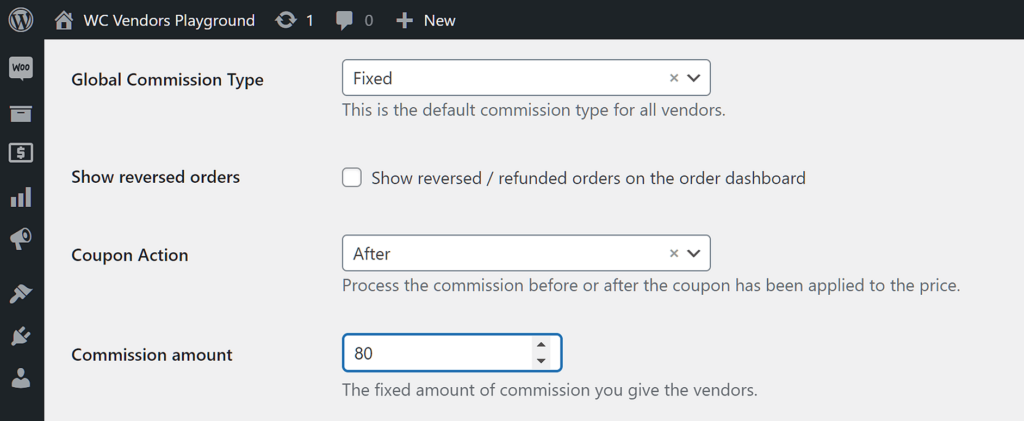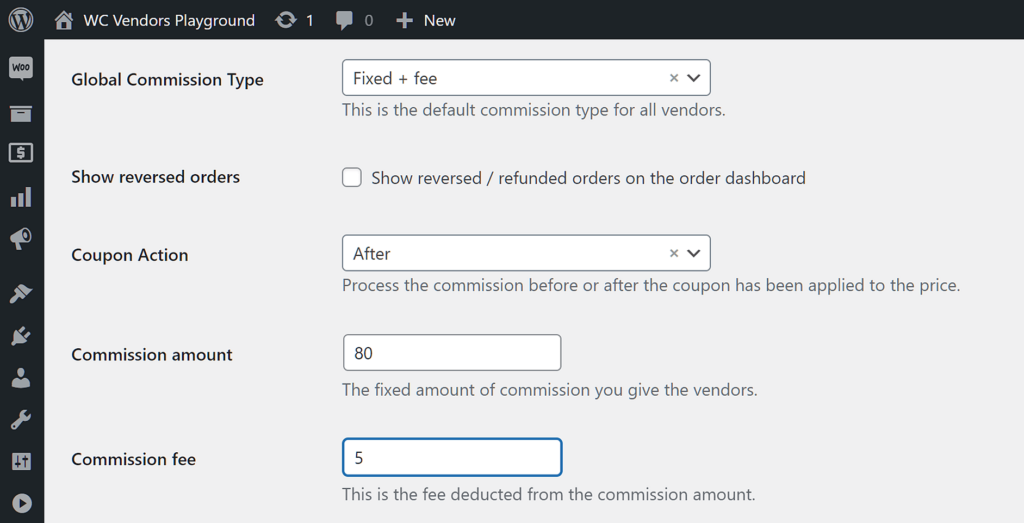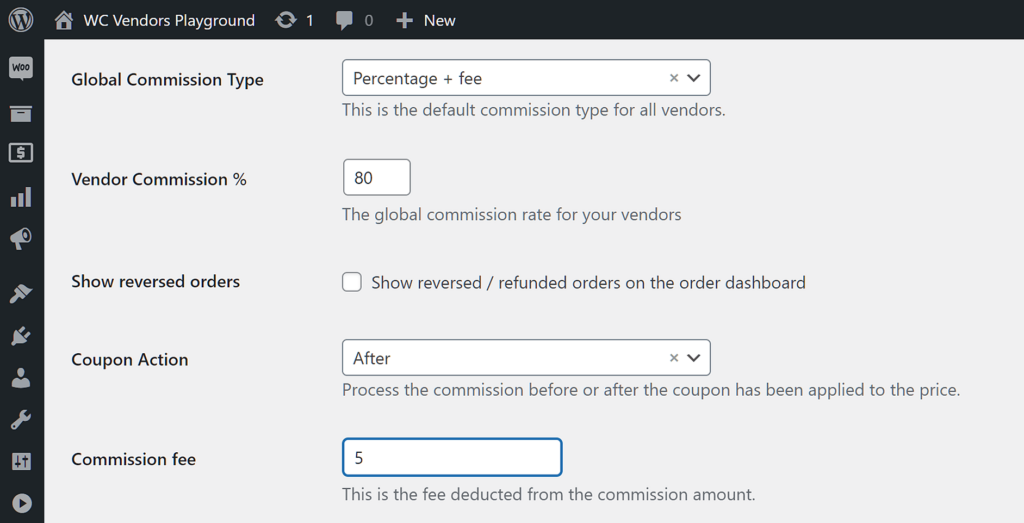
Commissions are among the most common and reliable ways for a marketplace and its vendors to earn profits. However, it’s important to know that various Standard Commission Types exist, with each having its own uses and advantages.
In a previous article, we discussed how to use WC Vendors to set up commissions for your multi-vendor marketplace. Today, we’ll discuss 4 of those commission types in greater detail, from their benefits to their applications. This way, you can determine which one is most ideal for your e-commerce business.
So let’s get right into it!
What Are Commissions?
Basically, a commission is the fee a platform owner gives vendors for each sale they make on their platform. In other words, when a vendor sells something on your multi-vendor marketplace, you award a portion of the total sale amount to the vendor before taking the rest for yourself. For instance, if a vendor sells a product worth $100, you might pay the vendor a commission of $80, and then charge them the remaining $20.
The commission rate varies based on your marketplace and the products sold. It can also differ for individual vendors or product categories.

WC Vendors Commission Types
WC Vendors has an advanced commission system, boasting 7 commission types, that lets you have control over how vendors are paid and charged. As you can see below, the first 4 are called Standard Commission Types, while the last 3 are known as Tiered Commission Types:
Standard Commission Types:
Tiered Commission Types:
- Vendor Sales
- Product Sales
- Product Price Sales
In this article, we’ll be focusing on Standard Commission Types.
Take note: In WC Vendors, the commission rate/amount always refers to the money given to the vendor.
Standard Commission Types
Standard Commission Types are relatively straightforward payment structures. They are as follows:
1. Fixed
The Fixed commission model awards vendors a set, unchanging sum for every sale, irrespective of the sale’s monetary value.
Let’s say a vendor successfully sells a product for $100. If you’ve established a fixed commission at $80, then the vendor earns $80, leaving the marketplace with $20.
Benefits
- Predictable earnings: Vendors can easily predict how much they’ll make because the fixed commission model gives them the same amount for every sale, no matter what the product costs.
- Simplicity and ease of understanding: The fixed commission is simple. Everyone, from vendors to platform administrators, can comprehend and implement it without doing complicated calculations.
- Incentive for high-value sales: Vendors may be encouraged to focus on selling higher-value products because the fixed commission doesn’t change based on the price. This can align with marketplace goals and promote the offering of premium items.
Drawbacks
- Lack of flexibility: The fixed commission doesn’t work well if you want to change how you charge for different products or if the market is always changing.
- Potential profit margin issues: When some products don’t make much money, the fixed commission might hurt vendors disproportionately. Unfortunately, this could discourage them from selling less expensive items. This, in turn, could also be a problem if the marketplace offers many different-priced products.
- Limited incentive for product variety: Since vendors earn the same fixed amount for every sale, they might not be motivated to offer a diverse range of products. This could result in a marketplace with fewer choices for customers, potentially limiting overall sales and market appeal.
Applications
- Consistent product pricing structure: Of the four Standard Commission Types, this one is the most ideal for platforms that offer similarly priced products. After all, the consistent pricing structure ensures everyone pays the same commission for their sales.
- Standardized sales efforts: Fixed commissions are suitable for marketplaces where the effort or resources required to make a sale don’t significantly vary across products.
- Simplified commission calculations: This Standard Commission Type is useful when you need to simplify the commission calculations for administrators and vendors. It’s clear and simple, making everything easier to manage.
2. Fixed + Fee
Like the previous Standard Commission Type, Fixed + Fee grants vendors a flat, fixed sum for each sale. However, it also subtracts a fixed fee from their commission, while said fixed fee goes to the marketplace.
For instance, if a vendor has products valued at $100 each, and you set the commission to $80 with a commission fee of $5, then the vendor takes home $75 (80 – 5 = 75). Meanwhile, the marketplace receives $25 (120 – 80 + 5 = 25).
Benefits
- Predictable earnings: Vendors get the same fixed amount for every sale, so they always know what to expect in their earnings.
- Revenue stream for the marketplace: The fixed fee ensures that the marketplace consistently earns money, making the financial situation more stable.
- Adaptable to specific costs: The fixed fee taken from the vendor’s commission allows for adjustments to cover specific costs or services without altering the core commission structure.
Drawbacks
- Complex fee structure: The combination of a fixed commission and a subtracted fixed fee might introduce complexity. Vendors need to fully understand how the calculations work.
- Potential impact on vendor motivation: Even though the fixed fee helps the marketplace make money, it slightly lowers the vendor’s earnings compared to a plain fixed commission. This could impact how motivated vendors feel.
- Uneven profits for products: Some products might make more or less money because of the fixed fee, which can affect how much vendors earn. It’s something vendors need to think about, especially if they sell different-priced items.
Applications
- Consistent product pricing structure: Out of the four commission types this is the best for platforms where all the products have similar prices. Basically, it keeps everything fair with the same commission for everyone.
- Flexible revenue generation: This Standard Commission Type is ideal when a marketplace wants to make money through a fixed fee and still give vendors a steady commission for their sales.
- Tailored commission approach: This model is ideal when a marketplace wants a commission setup that can be adjusted for specific costs or services, offering flexibility in managing finances.
3. Percentage
Using the Percentage Standard Commission Type, vendors receive a specific percentage of the total sale amount generated on the marketplace. Basically, the vendor commission percentage that you establish represents the portion of the total sale retained by the vendor.
For example, if a vendor is selling a product priced at $100 and you set the vendor commission percentage to 80%, then the vendor will receive $80 for each sale of that product. On the other hand, the marketplace retains $20.
Take note: Of all the commission types, Percentage is the only one that’s available for the free version of WC Vendors.
Benefits
- Variable earnings potential: Vendors have the freedom to earn different amounts based on what they sell. This is handy when there’s a mix of product prices on the marketplace.
- Incentive for high-value sales: Because the commission increases as the total sale amount goes up, vendors are encouraged to focus on selling more expensive products. This fits with what the marketplace wants and motivates vendors to offer higher-value items.
- Dynamic profit sharing: The percentage-based model ensures that when the marketplace grows and makes more money, vendors also get a fair share. Everyone benefits together, making sure revenue is distributed evenly as the marketplace expands.
Drawbacks
- Varied revenue predictability: Vendors might find it challenging to predict how much they’ll make because their earnings can change a lot with the percentage model. This can be tricky, especially when sales go up and down.
- Complexity for vendors: Calculating earnings under the percentage system can be a bit complicated. This is especially true when there’s a broad range of product prices.
- Potential inequity for low-priced items: Vendors might not earn as much when they sell lower-priced items because the commission is tied to the sale amount. This might not be great for vendors who focus on affordable products.
Applications
- Diverse product pricing structures: Of the various Standard Commission Types, the percentage model adapts well to different product prices. Therefore, it’s ideal for marketplaces where products vary significantly in price.
- Encouraging premium offerings: This is great for platforms that want to promote and reward vendors for selling pricier or premium products. The commission increases with the sale price, providing an incentive for vendors to focus on such items.
- Responsive to market conditions: This, of all Standard Commission Types, is extremely useful in markets where product values may fluctuate. The commission adjusts to these changes, keeping things fair.
- Tailored incentives for vendors: This Standard Commission Type is effective when a marketplace wants to reward vendors based on how well they sell. Vendors get a percentage of their actual sales, pushing them to do their best on the platform.
- Reflective of sales efforts: This model is appropriate for marketplaces where it takes different amounts of work to sell different products. The percentage model reflects how much effort vendors put into each sale.
4. Percentage + Fee
The Percentage + Fee Standard Commission Type entitles vendors to a percentage of the total sale amount, with the deduction of a fixed fee. Simply put, this fee is subtracted from the commission they earn for each transaction.
For instance, suppose the vendor commission percentage is set to 80%, and a commission fee of $5 is applied. When a vendor sells a product valued at $100, they receive $75, while the marketplace gains $25.
Benefits
- Flexible earnings structure: Vendors benefit from a commission structure that combines a percentage of the sale amount with a fixed fee deduction. This helps them earn money in a flexible way, adjusting to different sales situations.
- Revenue stream for the marketplace: Including a fixed fee ensures the marketplace always makes money consistently. This steady income helps keep the financial situation stable.
- Incentive for high-value sales: The model encourages vendors to focus on selling pricier items because the commission gets bigger as the total sale amount goes up. This fits with what the marketplace wants and gives vendors a reason to promote premium goods.
Drawbacks
- Complex fee structure: The combination of a percentage and a subtracted fixed fee may introduce complexity for vendors in understanding the calculations involved.
- Potential impact on vendor motivation: True, the fixed fee helps the marketplace make money. However, it could mean vendors earn a bit less compared to a system with only a percentage. This might affect how motivated vendors feel about selling on the platform.
- Uneven profits for products: Some products might make more or less money because of the fixed fee, and this can affect how much vendors earn. Vendors need to think about this, especially if they sell items with different price tags.
Applications
- Consistent product pricing structure: This Standard Commission Type is suitable for platforms with a consistent product pricing structure. It keeps everything fair by applying the same commission to everyone, maintaining uniformity in commission calculations.
- Flexible revenue generation: This model is ideal when a marketplace wants to make money through a fixed fee while giving vendors a steady commission for their sales. It’s like having two sources of income.
- Encouraging premium offerings: This is perfect for platforms that want vendors to focus on selling high-value or premium products. The combination of percentage and fee motivates vendors to showcase and sell those special items.
- Tailored incentives for vendors: This model is effective when a marketplace wants to reward vendors based on how well they sell. Vendors get a percentage of their actual sales, and the fixed fee allows for adjustments to cover specific costs or services.
- Reflective of sales efforts: Of the various Standard Commission Types, this is the most appropriate for marketplaces where the effort or resources required to sell may vary. The combination of percentage and fee reflects the sales performance and value of each transaction.
Choosing The Right Standard Commission Type For Your Marketplace
Picking the right Standard Commission Type is a vital decision for your online multi-vendor platform. After all, it impacts your earning system, your relationship with your vendors, and the overall success of your platform.
Ultimately, the choice depends on your marketplace’s unique goals and characteristics. Therefore, you should evaluate specific factors to guide you toward the most suitable commission model to use.
With that in mind, here are the major factors to consider when determining the appropriate Standard Commission Type for your marketplace:
1. Consider your product range
If your platform offers products with similar prices, a Fixed commission might be the best choice, as it ensures uniformity in commission payments.
However, for platforms with diverse product pricing, a Percentage commission could be more suitable. This is because it allows for flexibility in earnings based on the sale amount.
2. Product variety
Is your aim to encourage a wide variety of products on your platform? Then a percentage-based model might be ideal, as it provides vendors with the flexibility to offer products at various price points.
3. Vendor motivation
Do you want to incentivize vendors to focus on high-value sales and premium offerings? Then consider Percentage or Percentage + Fee. After all, these commission types reward vendors for selling more expensive products.
4. Financial stability and predictability
If you prioritize financial stability and want to ensure a steady income stream for your marketplace, models with fixed components, such as Fixed + Fee or Percentage + Fee, can help you achieve consistent earnings.
For marketplace owners and vendors who prefer predictable earnings and straightforward calculations, the Fixed commission type is an excellent choice. It provides clarity and simplicity in understanding potential income.
5. Adaptability to market changes
If your marketplace operates in a dynamic market where product values may fluctuate, a Percentage commission type could be more adaptive. This model adjusts to changes in the market, ensuring fairness.
6. Complexity tolerance
Consider the complexity tolerance of your vendors. If simplicity is key, the Fixed commission types are the easiest to understand. On the other hand, the Percentage commission types involve more complex calculations.
7. Balancing marketplace and vendor interests
Assess the balance between generating revenue for the marketplace and maintaining vendor satisfaction. Models like Fixed + Fee and Percentage + Fee strike a balance by providing a steady income for the marketplace while offering vendors a commission on sales.
Ensure that the selected Standard Commission Type aligns with your financial goals for your marketplace without discouraging vendors from participating.
Additional Resources
Want to learn more about commissions? Then check out the following articles, which discuss commissions in extensive detail:
- How To Charge Vendors In Your Marketplace: A WooCommerce Commissions Guide
- Tiered Commission Mastery: Amazing Advantages And Uses For Your Marketplace
- Power And Versatility: The Awesome Benefits Commission Levels Offer Marketplaces
We also invite you to read the Commissions documentation on our Knowledge Base!

Conclusion
Standard Commission Types are crucial to a marketplace’s ability to generate revenue. And because choosing the right one for your platform is important, it’s an excellent idea to consider the benefits, drawbacks, and applications of each.
To recap, here are the 4 Standard Commission Types WC Vendors offers:
In addition, look into the various factors that can help you determine the ideal Standard Commission Type for your multi-vendor marketplace.
Do you have any questions about Standard Commission Types? Reach out to us and let us know!




